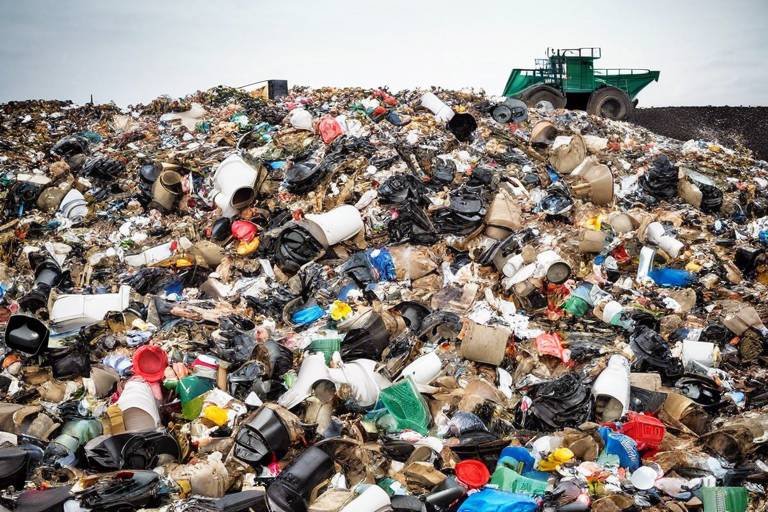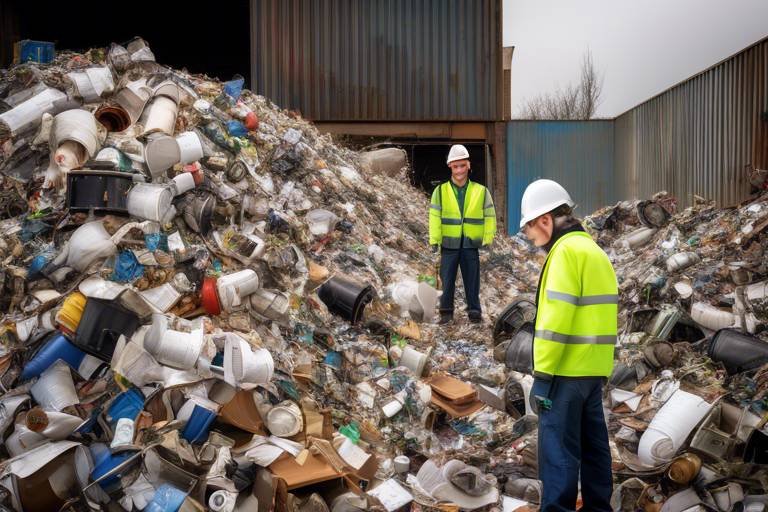What is the Link Between Food Waste and World Hunger?
Food waste and world hunger are two sides of the same coin, yet they often seem worlds apart. Imagine a banquet table, lavishly spread with food, yet countless individuals are left hungry just outside the door. This stark contrast highlights a critical issue we face globally: while we throw away about one-third of the food produced for human consumption, nearly 690 million people go to bed hungry each night. This article dives deep into the intricate relationship between food waste and global hunger, illustrating how the two are interconnected and what can be done to bridge this gap.
The reality is that food waste isn't just a matter of throwing away leftovers or expired goods. It encompasses a vast array of factors, including production inefficiencies, consumer habits, and systemic issues within our food supply chains. Each year, around 1.3 billion tons of food is wasted, which could otherwise nourish millions. This staggering statistic is not just a number; it's a representation of the resources—water, labor, land, and energy—used to produce that food, most of which goes to waste. As we delve deeper into this topic, we will uncover the causes, consequences, and potential solutions to this pressing issue that affects millions worldwide.
Understanding the link between food waste and hunger is not merely an academic exercise; it's a call to action. By recognizing how our food systems operate and the impact of our choices, we can begin to address the root causes of these two interconnected crises. The question remains: how can we transform our relationship with food to ensure that everyone has access to the nourishment they need? Through awareness, education, and community-driven initiatives, we can pave the way toward a more sustainable and equitable food system.
Food waste refers to the discarding of edible food at various stages of the supply chain. This section delves into statistics and definitions, shedding light on the magnitude of the problem globally.
Food waste exacerbates hunger by diverting resources away from those in need. This section examines how wasted food could feed millions and discusses the ethical implications of this crisis.
Several factors contribute to food waste, including overproduction, consumer behavior, and inadequate storage. This subsection explores these causes to better understand why food is wasted at alarming rates.
Consumer habits significantly influence food waste. This part discusses how purchasing patterns, expiration dates, and portion sizes contribute to the problem, emphasizing the role of individuals in reducing waste.
Inefficiencies in the food supply chain lead to significant waste. This section outlines how logistical challenges, spoilage, and lack of infrastructure contribute to food loss before it reaches consumers.
The repercussions of food waste extend beyond hunger, impacting the environment and economy. This section highlights the ecological footprint of wasted food and its economic implications for societies worldwide.
Addressing food waste requires a multi-faceted approach. This section outlines practical strategies for individuals, businesses, and governments to minimize waste and redirect surplus food to those in need.
Community-driven initiatives play a crucial role in reducing food waste. This subsection showcases successful programs and partnerships that aim to redistribute food and raise awareness about hunger and waste.
Government policies can significantly impact food waste reduction. This part discusses potential legislative measures and incentives that can encourage sustainable practices and support food recovery efforts.
- What are the main causes of food waste? Food waste occurs due to overproduction, consumer behavior, and supply chain inefficiencies.
- How does food waste contribute to world hunger? Wasted food represents resources that could have been used to feed those in need, exacerbating hunger issues globally.
- What can individuals do to reduce food waste? Individuals can plan meals, understand expiration dates, and donate surplus food to local charities.
- How can governments help reduce food waste? Governments can implement policies that promote food recovery and provide incentives for businesses to minimize waste.

Understanding Food Waste
Food waste is a pressing global issue that refers to the discarding of edible food at various stages of the supply chain, from production to consumption. It's astonishing to think that approximately 1.3 billion tons of food are wasted every year, which is nearly one-third of all food produced for human consumption. This staggering statistic not only highlights the scale of the problem but also raises critical questions about how we, as a society, manage our resources. The implications of food waste are profound, affecting not just those who go hungry but also our environment and economy.
To truly grasp the magnitude of food waste, we need to break it down into its various components. Food waste occurs at different stages, including:
- Production: Farmers often discard fruits and vegetables that don’t meet aesthetic standards, even if they are perfectly edible.
- Processing: During the processing phase, a significant amount of food is lost due to inefficiencies or mishandling.
- Distribution: Logistical challenges can lead to spoilage before food even reaches stores or consumers.
- Consumption: Households frequently throw away food due to over-purchasing or misunderstanding expiration dates.
This multi-faceted nature of food waste makes it a complex issue to tackle. In developed countries, most waste occurs at the consumer level, while in developing nations, the majority of food loss happens earlier in the supply chain. This discrepancy underscores the need for tailored solutions that address the specific causes of waste in different contexts.
Moreover, the environmental impact of food waste cannot be overstated. When food is thrown away, it not only wastes the resources used to produce it—such as water, land, and energy—but also contributes to greenhouse gas emissions. In fact, food waste accounts for about 8-10% of global greenhouse gas emissions. This means that by reducing food waste, we can significantly mitigate our carbon footprint and work towards a more sustainable future.
In summary, understanding food waste is not just about recognizing the statistics; it's about grasping the broader implications for our world. With millions of people suffering from hunger while we waste an astonishing amount of food, it becomes imperative to find solutions that not only reduce waste but also ensure that surplus food is redirected to those in need. The journey towards minimizing food waste begins with awareness and education, and it’s a journey we must all embark on together.

The Impact of Food Waste on Hunger
Food waste is not just a statistic; it’s a heartbreaking reality that has a direct impact on global hunger. Imagine this: approximately one-third of all food produced for human consumption is wasted each year. That’s around 1.3 billion tons of food! To put it into perspective, this amount could feed billions of people who are struggling with hunger. The irony here is staggering—while some people are throwing away perfectly good food, others are going to bed hungry.
The diversion of resources due to food waste creates a ripple effect that exacerbates hunger. When food is discarded, not only are we wasting the food itself, but we’re also squandering the water, labor, and energy that went into producing it. This is where the ethical implications kick in. How can we justify wasting food when millions are starving? It raises a moral dilemma that we must confront as a society.
According to the Food and Agriculture Organization (FAO), if we could redirect just a fraction of the food that is wasted, we could significantly alleviate hunger. For instance, here are some shocking statistics:
| Region | Food Waste (Million Tons) | People Who Could Be Fed |
|---|---|---|
| North America | 60 | 50 million |
| Sub-Saharan Africa | 40 | 30 million |
| Europe | 90 | 70 million |
This table illustrates the staggering amount of food waste in different regions and the number of people that could potentially be fed if that food was redirected. It’s a clear call to action for us to rethink our food systems and how we manage resources.
Moreover, food waste contributes to hunger not just in terms of quantity but also in quality. Often, the food that is wasted is fresh produce, which is essential for a nutritious diet. When this food is thrown away, it deprives those in need of vital nutrients. The cycle continues as those who are food insecure often rely on food banks and charitable organizations that may not have the resources to provide fresh, healthy options.
In light of these facts, it’s crucial to recognize that tackling food waste is not merely an environmental issue; it’s a humanitarian one. We must ask ourselves: how can we change our habits to reduce waste? What role can we play in ensuring that food reaches those who need it most? By addressing food waste, we are taking a step towards a more equitable world where everyone has access to the nourishment they deserve.
In conclusion, the impact of food waste on hunger is profound and multifaceted. It’s not just about the food that ends up in landfills; it’s about the lives that could be saved and the hunger that could be alleviated. As we move forward, let’s commit to being part of the solution. Together, we can turn the tide on hunger and waste, ensuring a better future for all.
- What is food waste? Food waste refers to the discarding of edible food at various stages of the supply chain, from production to consumption.
- How does food waste contribute to hunger? Food waste diverts resources away from those in need and contributes to the scarcity of nutritious food for vulnerable populations.
- What can individuals do to reduce food waste? Individuals can plan meals, buy only what they need, and properly store food to extend its shelf life.
- Are there policies in place to address food waste? Yes, many governments are implementing policies to encourage food recovery and reduce waste at multiple levels.

Causes of Food Waste
Food waste is a multifaceted issue that arises from a variety of factors, all of which intertwine in complex ways. One of the primary contributors is overproduction. Farmers and producers often cultivate more food than is necessary to meet market demands, driven by the fear of shortages. This excess, unfortunately, often ends up in landfills rather than on our plates. Imagine a baker preparing a dozen extra loaves of bread, only to see them tossed aside when they don’t sell. It’s a heartbreaking reality that reflects the broader issue of food waste.
Another significant factor is consumer behavior. Many shoppers are drawn to the idea of buying in bulk, which can lead to purchasing more food than they can consume before it spoils. The psychology of shopping often encourages us to stock up, but this can backfire when we forget about those items lurking at the back of the fridge. According to recent studies, it’s estimated that 40% of food waste occurs at the consumer level. Think about it: how many times have you tossed out a half-eaten container of yogurt or a bag of wilted spinach?
Furthermore, expiration dates can also mislead consumers. Many people mistakenly interpret these dates as definitive indicators of safety, leading them to discard food that is still perfectly edible. The difference between 'sell by' and 'use by' dates can be confusing, and this confusion contributes significantly to the waste problem. A simple understanding of these labels can drastically reduce waste.
In addition to consumer habits, inefficiencies in the supply chain play a crucial role in food waste. From production to distribution, many obstacles can arise. For instance, logistical challenges such as poor transportation routes can lead to spoilage before food even reaches the market. In developing countries, lack of proper storage facilities can exacerbate this issue, where fruits and vegetables may perish before they can be sold. A staggering amount of fresh produce is lost due to these preventable inefficiencies.
To paint a clearer picture, consider the following table that summarizes the key causes of food waste:
| Cause | Description |
|---|---|
| Overproduction | Producing more food than needed to meet demand, resulting in surplus. |
| Consumer Behavior | Buying habits that lead to excess food purchases and waste. |
| Expiration Dates | Misinterpretation of food labels causing premature disposal. |
| Supply Chain Inefficiencies | Logistical issues and lack of infrastructure leading to spoilage. |
Ultimately, addressing the causes of food waste requires a collective effort. By understanding these factors, consumers can make more informed choices, while producers and retailers can implement better practices to minimize waste. It’s not just about saving money; it’s about making a conscious effort to respect the resources that go into food production. After all, every meal we waste is a meal someone else could have enjoyed.
Q: What is the most significant cause of food waste?
A: While there are many causes, consumer behavior and overproduction are often cited as the leading contributors to food waste.
Q: How can I reduce food waste at home?
A: You can reduce food waste by planning meals, understanding expiration dates, and being mindful of purchasing habits.
Q: Are there any community programs to help reduce food waste?
A: Yes, many communities have food recovery programs that redistribute surplus food to those in need.

Consumer Behavior and Waste
When it comes to food waste, one of the biggest culprits is often right in our own kitchens. Yes, you guessed it—it's our consumer behavior. Think about it: how many times have you thrown away food that was perfectly edible? It’s a common scenario. The way we shop, store, and consume food plays a monumental role in the staggering amounts of waste generated every year. In fact, studies show that a significant portion of food waste occurs at the consumer level, highlighting the need for a shift in our habits.
One major factor contributing to this issue is our shopping patterns. Many of us tend to buy in bulk, lured by discounts or the allure of stocking up. While this might seem like a savvy move, it often leads to food spoiling before we have a chance to consume it. According to the Food and Agriculture Organization (FAO), approximately 1.3 billion tons of food are wasted globally each year, and a large part of this waste is linked to consumer purchasing choices. The irony? That wasted food could have fed millions of people in need.
Expiration dates also play a significant role in consumer waste. Many individuals misinterpret "sell by" and "use by" dates, leading to perfectly good food being discarded prematurely. It's essential to understand that these dates are often more about quality than safety. For instance, a carton of milk might be labeled as expired, but it could still be perfectly fine for a few days after that date. This misunderstanding leads to unnecessary waste and highlights the need for better education on food labeling.
Portion sizes are another critical aspect of consumer behavior that contributes to waste. Many of us serve larger portions than we can realistically eat, resulting in leftovers that often end up in the trash. A simple solution to this problem could be to practice mindful eating and serve smaller portions, allowing us to enjoy our meals without the guilt of wasting food. Additionally, getting creative with leftovers can be a fun challenge—who doesn’t love a good leftover stir-fry or soup?
To tackle these issues effectively, we need to foster a culture of awareness and responsibility around food consumption. Here are a few strategies that can help:
- Plan Your Meals: Taking the time to plan meals can drastically reduce impulse buying and ensure that you only purchase what you need.
- Understand Labels: Familiarize yourself with food labeling to prevent premature disposal of edible items.
- Practice Mindful Eating: Serving smaller portions and being conscious of what you eat can help minimize waste.
By making small adjustments to our shopping habits and being more mindful about how we consume food, we can collectively make a significant impact on reducing food waste. Remember, every little change counts, and together, we can contribute to a more sustainable future.
Q: What is the biggest cause of food waste at the consumer level?
A: The biggest causes include over-purchasing, misunderstanding expiration dates, and serving large portion sizes.
Q: How can I reduce food waste in my household?
A: Planning meals, understanding food labels, and practicing portion control can significantly help in reducing food waste.
Q: What happens to food that is wasted?
A: Wasted food often ends up in landfills, where it decomposes and produces methane, a potent greenhouse gas that contributes to climate change.

Supply Chain Inefficiencies
When we think about food waste, it's easy to picture a half-eaten meal thrown away or a forgotten loaf of bread going stale. However, the reality is much more complex, especially when we dive into the inefficiencies of the food supply chain. This intricate web, stretching from farms to our kitchen tables, is riddled with challenges that lead to significant food loss before it even reaches consumers. Did you know that approximately 1/3 of all food produced globally is wasted? That's a staggering statistic that highlights the scale of the issue.
One of the primary culprits behind this waste is the lack of proper logistical infrastructure. In many regions, especially in developing countries, roads and transportation systems are inadequate, making it difficult to move food from producers to markets quickly. This delay can result in spoilage, particularly for perishable items like fruits and vegetables. For instance, a farmer might harvest a bumper crop of tomatoes, but if they can't get them to market in time due to poor transport conditions, those tomatoes could end up rotting in the field.
Another significant factor is the storage capabilities of the supply chain. Without proper refrigeration or storage facilities, food can spoil before it even reaches the consumer. According to the Food and Agriculture Organization (FAO), around 40% of food loss occurs during the post-harvest stage due to inadequate storage. This is particularly evident in regions where farmers lack access to modern technology that can preserve their harvests. Imagine a world where all that wasted food could have fed countless hungry mouths instead!
Additionally, inefficiencies in processing contribute to food waste. Sometimes, food products are deemed unfit for sale because they don't meet certain aesthetic standards—think of those perfectly edible but oddly shaped fruits and vegetables that never make it to the grocery store shelves. This practice not only wastes food but also resources used in production, transportation, and storage.
To illustrate the impact of these inefficiencies, consider the following table that outlines different stages of the food supply chain and the corresponding waste percentages:
| Stage of Supply Chain | Percentage of Food Wasted |
|---|---|
| Production | 20% |
| Post-Harvest | 40% |
| Processing | 10% |
| Distribution | 5% |
| Retail | 15% |
| Consumer | 10% |
In summary, the inefficiencies in the food supply chain are a major contributor to food waste, creating a ripple effect that exacerbates hunger and environmental issues. By addressing these inefficiencies, we can not only reduce waste but also ensure that more food reaches those who need it most. It's a complex challenge, but one that is entirely possible to tackle with the right strategies and innovations.

Consequences of Food Waste
Food waste is not just a matter of throwing away leftovers; it has profound consequences that ripple through our environment, economy, and society. When we waste food, we're not only discarding something that could have nourished someone in need, but we're also squandering the resources that went into producing, transporting, and storing that food. To put it into perspective, consider this: for every 1 kilogram of food wasted, we waste about 4,000 liters of water, not to mention the energy used in production and transportation. It’s like pouring water down the drain while someone nearby is thirsty.
The environmental impact of food waste is staggering. When food ends up in landfills, it decomposes and releases methane, a greenhouse gas that is significantly more potent than carbon dioxide. According to the Food and Agriculture Organization (FAO), if food waste were a country, it would be the third largest emitter of greenhouse gases in the world, trailing only the United States and China. This means that our food waste not only contributes to global warming but also exacerbates the climate crisis we are currently facing.
Moreover, the economic implications of food waste are equally concerning. The FAO estimates that around $1 trillion worth of food is wasted every year globally. This is money that could have been used to improve food security, invest in sustainable farming practices, or support local economies. For families, especially those living paycheck to paycheck, food waste can mean the difference between having enough to eat and struggling to make ends meet. It's a stark reminder that while some people waste food, others are left to navigate the harsh realities of hunger.
Additionally, the social consequences of food waste can’t be overlooked. In a world where over 800 million people go hungry, it's disheartening to think that the food we waste could have provided meals for millions. This disconnect between abundance and scarcity raises ethical questions about our consumption habits. Are we, as a society, doing enough to address the food waste crisis while so many are suffering from hunger? The answer is a resounding no, and it calls for a collective effort to change our habits and perceptions about food.
In summary, the consequences of food waste are far-reaching and multifaceted. From environmental degradation and economic loss to social injustice, the impacts are profound. Tackling food waste is not just an individual responsibility; it requires a concerted effort from communities, businesses, and governments alike. We must recognize that reducing food waste is a crucial step toward alleviating hunger and creating a more sustainable future.
- What are the main causes of food waste?
Food waste is primarily caused by overproduction, consumer behavior, and supply chain inefficiencies. - How does food waste affect the environment?
When food waste decomposes in landfills, it produces methane, a potent greenhouse gas that contributes to climate change. - What can individuals do to reduce food waste?
Individuals can plan meals, buy only what they need, and properly store food to extend its shelf life. - Are there community initiatives to help reduce food waste?
Yes, many communities have programs that redistribute surplus food to those in need and raise awareness about food waste.

Solutions to Reduce Food Waste
Reducing food waste is not just a noble endeavor; it’s a necessity that requires a concerted effort from individuals, businesses, and governments alike. By implementing practical strategies, we can significantly minimize waste and redirect surplus food to those who need it most. Imagine a world where every meal is savored, and no food is left to rot in landfills. Sounds ideal, right? Well, it’s achievable if we all play our part!
First and foremost, individuals can start by being more mindful of their purchasing habits. This means planning meals ahead of time, creating shopping lists, and avoiding impulse buys. When you go to the grocery store, think about what you truly need. Have you ever bought a bunch of bananas only to find them turning brown on the counter a week later? By being intentional about your purchases, you can drastically cut down on waste at home.
Businesses also have a crucial role to play in this fight against food waste. Many restaurants and supermarkets are now embracing innovative practices to reduce their surplus. For instance, some establishments have begun offering "ugly" fruits and vegetables at a discount, making it clear that these items are just as nutritious as their more aesthetically pleasing counterparts. Not only does this help to reduce waste, but it also encourages consumers to rethink their perceptions of food quality. Furthermore, businesses can partner with local food banks and charities to donate excess food rather than throwing it away. This not only helps feed those in need but also enhances the company's community image.
On a larger scale, government policies can create a significant impact. Legislation that incentivizes food recovery efforts can encourage businesses to donate food rather than discard it. For example, tax deductions for food donations can motivate companies to participate in food recovery programs. Additionally, governments can implement educational campaigns aimed at raising awareness about food waste and its consequences. By informing the public about the issue, we can inspire collective action towards reducing waste.
Community initiatives are another powerful solution. Local organizations can set up food-sharing programs, where surplus food from households and businesses is collected and redistributed to those in need. These programs not only provide food security but also foster a sense of community and collaboration. Imagine a neighborhood where everyone shares their excess produce, creating a sustainable cycle of giving. It’s a beautiful concept that can be realized with the right support and commitment.
In summary, the solutions to reducing food waste are varied and multifaceted. From individual actions to community programs and government policies, every effort counts. By working together, we can tackle this pressing issue and ensure that food reaches those who need it most, while also protecting our planet. So, what steps will you take today to reduce food waste in your life?
- What are some everyday tips to reduce food waste? Start by planning your meals, using leftovers creatively, and storing food properly to extend its shelf life.
- How can I get involved in local food recovery efforts? Look for community organizations that focus on food redistribution and volunteer your time or resources.
- Are there apps to help reduce food waste? Yes, there are several apps available that connect consumers with local businesses offering discounted food items that are nearing their expiration dates.
- What role do schools play in reducing food waste? Schools can implement programs that educate students about food waste and encourage them to adopt sustainable practices.

Community Initiatives
Community initiatives are vital in tackling the dual challenges of food waste and hunger. These grassroots efforts not only help redistribute surplus food but also foster a sense of community and collective responsibility. Imagine a neighborhood where no one goes hungry, and at the same time, food waste is minimized. Sounds like a dream, right? But with the right initiatives, this dream can become a reality.
One of the most effective ways communities are addressing food waste is through food recovery networks. These networks connect food businesses, such as grocery stores and restaurants, with local charities and food banks. By partnering with these organizations, businesses can donate unsold or excess food, which is then distributed to those in need. This not only prevents perfectly good food from ending up in landfills but also provides meals for families who might otherwise struggle to put food on the table.
For example, the Food Rescue US program has made significant strides in this area. Volunteers use a mobile app to pick up surplus food from businesses and deliver it to local shelters or food pantries. This simple yet effective model has resulted in millions of meals being rescued and distributed, showcasing how technology can play a role in solving real-world problems.
Moreover, community gardens are another fantastic initiative gaining traction. These gardens allow residents to grow their own fruits and vegetables, which not only provides fresh produce but also teaches valuable skills about sustainable agriculture. When communities come together to cultivate their own food, they reduce reliance on store-bought items that often contribute to food waste due to spoilage or over-purchasing. Plus, the sense of camaraderie that develops among gardeners can lead to further initiatives aimed at reducing food waste.
Additionally, educational programs are crucial for raising awareness about food waste and hunger. Schools, community centers, and local organizations often host workshops that teach individuals about proper food storage, meal planning, and creative ways to use leftovers. By equipping people with knowledge, we empower them to make informed decisions that can significantly reduce waste. For instance, knowing how to store fruits and vegetables to extend their shelf life can prevent them from spoiling before they are consumed.
To illustrate the impact of community initiatives, consider the following table that outlines some successful programs across the globe:
| Program Name | Location | Key Focus | Impact |
|---|---|---|---|
| Food Rescue US | USA | Food Recovery | Millions of meals rescued |
| City Harvest | New York City, USA | Food Redistribution | Over 60 million pounds of food rescued annually |
| FareShare | UK | Food Redistribution | Over 1 million meals provided weekly |
| Community Garden Network | Various Locations | Sustainable Agriculture | Increased access to fresh produce |
In conclusion, community initiatives are a powerful tool in the fight against food waste and hunger. By engaging local residents, leveraging technology, and fostering education, these programs create a ripple effect that can lead to significant change. The more we invest in our communities and support these initiatives, the closer we get to a world where food waste is minimized, and hunger is eradicated.
Q: How can I get involved in community initiatives to reduce food waste?
A: You can start by volunteering at local food banks, joining community garden projects, or participating in food recovery programs in your area.
Q: What are some simple ways to reduce food waste at home?
A: Meal planning, proper food storage, and using leftovers creatively are great ways to minimize waste at home.
Q: Are there any apps that help with food recovery?
A: Yes, apps like Food Rescue US and Too Good To Go connect users with surplus food from businesses, allowing them to rescue food that would otherwise go to waste.
Q: Why is it important to address food waste and hunger together?
A: Addressing both issues simultaneously creates a more sustainable food system and ensures that resources are used efficiently, helping those in need without compromising the environment.

Policy Changes
When it comes to tackling the issue of food waste, government policies can serve as a powerful catalyst for change. By implementing strategic legislative measures, governments can create an environment that encourages sustainable practices and supports food recovery initiatives. Imagine a world where every piece of food that is produced is utilized effectively; this is not just a dream but a possibility if we take the right steps now. Policies can incentivize businesses to donate surplus food instead of discarding it, thus redirecting valuable resources to those in need.
One effective approach is to introduce tax incentives for companies that donate food. By offering tax deductions for food donations, businesses are more likely to participate in food recovery programs. This not only helps reduce waste but also supports local charities and food banks that struggle to meet the demand. Furthermore, governments can establish food recovery networks that connect food donors with organizations that feed the hungry. These networks can streamline the process, making it easier for businesses to contribute without the fear of liability or logistical challenges.
Moreover, implementing regulations on expiration dates can significantly reduce food waste. Many consumers are misled by “sell by” and “best before” dates, leading to perfectly edible food being thrown away. By standardizing these labels and educating the public about their meanings, we can change consumer behavior and reduce unnecessary waste at home. Additionally, policies that promote food waste audits in both households and businesses can help identify where waste occurs and develop targeted strategies to mitigate it.
To further solidify these changes, governments can invest in public awareness campaigns that educate citizens about the consequences of food waste and the importance of food recovery. These campaigns can highlight success stories from communities that have effectively reduced waste, inspiring others to follow suit. By fostering a culture of sustainability and community responsibility, we can create a ripple effect that encourages everyone to take action.
In conclusion, policy changes are essential for creating a sustainable food system that minimizes waste and addresses hunger. By adopting a multi-faceted approach that includes tax incentives, standardized labeling, and public education, we can pave the way for a future where food waste is significantly reduced, and those in need are supported. It’s time for governments to take the lead and make a difference in the fight against food waste and hunger.
- What are the main causes of food waste? Food waste is often caused by overproduction, consumer habits, and inefficiencies in the supply chain.
- How can individuals help reduce food waste? Individuals can help by planning meals, understanding expiration dates, and donating surplus food.
- What role do businesses play in reducing food waste? Businesses can participate by donating excess food, improving inventory management, and educating employees about waste reduction practices.
- Are there any successful examples of food recovery initiatives? Yes, many communities have implemented food recovery networks that connect food donors with local charities, effectively redistributing surplus food.
Frequently Asked Questions
- What is food waste?
Food waste refers to the discarding of edible food at various stages of the food supply chain. This includes everything from farms to grocery stores and even at home. It's a massive issue that affects millions of people globally, with a staggering amount of food being wasted while many go hungry.
- How does food waste contribute to world hunger?
Food waste exacerbates hunger by diverting resources away from those in need. When food is wasted, it means that the resources used to produce that food—like water, land, and labor—are also wasted. This could have been used to feed those who are hungry, highlighting the ethical implications of our food systems.
- What are the main causes of food waste?
Several factors contribute to food waste, including overproduction, consumer behavior, and inefficiencies in the supply chain. For instance, consumers often buy more than they need, leading to spoilage, while supply chain issues can cause food to be lost before it even reaches the shelves.
- How can I reduce food waste at home?
You can reduce food waste by planning your meals, buying only what you need, and properly storing food to extend its shelf life. Additionally, being mindful of expiration dates and using leftovers creatively can make a significant difference.
- What role do community initiatives play in reducing food waste?
Community initiatives are vital in tackling food waste. They help redistribute surplus food to those in need and raise awareness about the issues of hunger and waste. Programs like food banks and community fridges are great examples of how local efforts can make a big impact.
- What policies can help reduce food waste?
Government policies can significantly influence food waste reduction. Legislative measures that support food recovery, provide incentives for businesses to donate surplus food, and promote sustainable practices can all help in minimizing waste and addressing hunger.



















